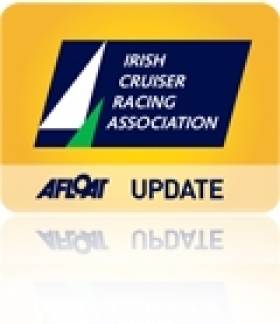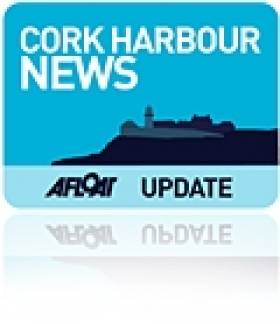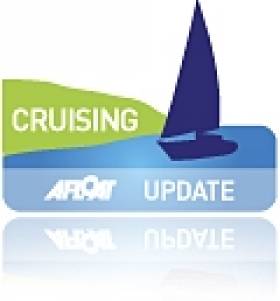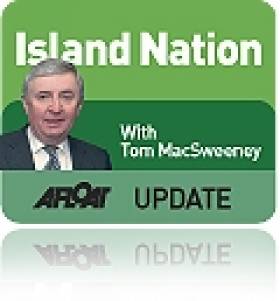Displaying items by tag: Crosshaven
ICRA Racing Underway in Crosshaven
The conditions were ideal with a 7–knot breeze coming from the S.E. with flat water, blue skies and at the top of the tide. The harbour was looking its best.
The Race Officer set an excellent course. A bit of bias on the line made the start a bit interesting though. Class One got away clean. But Classes two and three had a General Recall.
After the start at Grassy the fleet had a beat out to No.3 The usual debate ensued over which side of the course was favoured. It was a close call in the end. Around No. 3 to starboard, spinnaker up and back to the Cage Bouy. A gybe and then on to No.12 at this stage there was a nice bit of ebb in the tide. It really was a case off keeping the Spinny flying for as long as possible up to the Mark. A nice beat followed, down to Corkbeg and then a nice reach back to the Grassy where the S flag was flying.
It was a good night for Billy Duane in his Sunlight 30 Expression in the White Sail fleet and for Jimmy Nyhan and Maritta Buwalda in their 1/4 Tonner Outrigger in Class 3.
First places also went to Thunderbird a Corby 25 owned by Denis Coleman in Class 2 and Endgame an A35 owned by Frank Doyle in Class 1.
Regatta Entry Deadlines Looming
Deadlines for entry in to a number of this season's key sailing regattas are looming. Volvo Dun Laoghaire Regatta's significantly reduced early bird entry rate for the July 7th event will end on Monday and offshore racers intending to race in June 11th's 320-mile Dun Laoghaire to Dingle Race must enter by next Friday 20th. The ICRA Cruiser Championships in Crosshaven takes place from the 17th to 19th June, a fixture that suits those boats intending to compete in the Dingle race. Race details can be downloaded below.
1720 European Championships to be Launched on the Lee
The 1720 Sportsboat European Championships and the class national championships will be launched at a "Sailing By The Lee" event on Friday 29th April, 2011 where six 1720's will be raced on the River Lee adjacent to the Headquarters of the Port of Cork. The boats will be brought up river on the Thursday evening and racing will commence at lunch time on the Friday (see below for the Eddie English weather video) which say the class will provide photo and media opportunities at the new marina in the Port of Cork. Each boat will carry sponsorship flags.
In June up to 20 boats go back to their roots when the fleet gathers at Royal Cork Yacht Club for the CH Marine Sponsored National Championships.
A fleet of between 30-35 boats will contest the Corona sponsored Europeans when they set sail off Baltimore in September. There are already confirmed entries travelling from Scotland, Isle of Man, England and Wales while there is also interest coming from Holland where a fleet of eight boats is currently active.
The robust Irish 1720 design has been celebrating a comeback in recent years after cheating death by atrracting a strong following in West Cork, spearheaded by some of the rebel county's top sailors.
The fleet is rapidly becoming the most popular one design keel boat in this part of Ireland. There are now established and growing fleets at Royal Cork, Crosshaven, Kinsale, Baltimore and Schull while Galway Bay also has a growing fleet, racing in Galway Bay. The 2010 Nationals attracted a fleet of over twenty boats,
The series itself will be sailed over a three day period starting on Thursday, 1st September and consisting of nine races in total, three per day. Notice of Race and Entry Forms will be available shortly from Baltimore Sailing Club.
Tributes Paid to Cork Boat Builder George Bushe
Sailing tributes have been paid to legendary boat builder George Bushe, who died last week aged 89.
Born in Baltimore, Co Cork, Bushe got his start in boat building through his father, who make traditional punts. From there he went on to Skinner's Boatyard in Skibbereen and worked with the late Jack O'Driscoll in Ringaskiddy.
In the 1960s and '70s he worked at the Southcoast Boatyard in Rochestown, where be built many famous racing boats for Cork's premier sailing clans - such as the Golden Apple for the late Hugh Coveney, father of Minister for the Marine Simon Coveney.
Bushe went into semi-retirement in the 1970s, working at the Royal Cork Yacht Club, restoring boats in winter and even racing his own until the mid 2000s.
His remains were carried to St Patrick's Cemetary in Crosshaven aboard the Cánóg, the last boat he completed and which he raced competitively as recently as 2006.
George Bushe is survived by his wife Carmel and their children: Bernice, Fergus, sail maker Majella, shipwright Mark, and boat builder and sailor Killian Bushe, who just last month received the Fastnet Award for his own contributions to sailing.
The Irish Examiner has more on the story HERE.
Irish Cruising Club Present Fastnet Award to Killian Bushe
So whenever a high-powered strongly-resourced international challenge is taking shape, Bushe is the boat-builder of choice, favoured by leading designers and top skippers alike. But if you have a challenge in mind and he is top of the list, please join the queue.
For at the moment, he is immersed as leading consultant in building the new Groupama 4, the top French Volvo 70 for Franck Cammas. Before that, he built the two successful Ericsson boats for the last Volvo – they took first and fourth. In fact, he has built the overall winners of the last three Volvo races. And when Groupama 4 is launched in May and signed off for the race (which starts on October 29th) Bushe returns his focus to Sweden which is now his home, where he has been involved with the Artemis challenger for the America's Cup 2013.
For that project, the designer is Juan Kouyoumdjian, and the skipper is Paul Cayard. This is stratospheric stuff, but that's the level where Bushe operates. With more than thirty years of high tech boat building experience, and a string of success that is mind-boggling, he is the gold standard. But beyond that, he is still the Crosshaven kid who started his racing on his father George's Avocet (which George designed and built), and internationally he is the spirit of Cork sailing.
His renowned skill and knowledge in the use of advanced materials and composites is such that you'd expect him to be awarded a Honorary Doctorate in chemistry from some appropriate university. But in the meantime, his special place in Irish and world sailing was honoured on Saturday March 26th with his award of the Fastnet Trophy.
This trophy is co-ordinated by the Irish Cruising Club, and it operates in very broad brief. Initiated in 2005 with its first award to Paddy Barry and Jarlath Cunnane for their pioneering circuit of the Arctic via both the Northwest Passage and the Northeast Passage, its unique lineage has been maintained by such awardees as Robin Knox-Johnston, and the most recent one, centenarian circumnavigator Bill King of Galway.
The Fastnet Trophy is envisaged as highlighting a contribution to sailing which has a sense of the unique about it, and Killian Bushe is just the man. His international sailing achievements began back in 1976 when he was one of the crew that won the Half Ton Cup at Trieste in the Cork-built Silver Shamrock. They celebrated by sailing up the Grand Canal in Venice with spinnaker set. But gradually the boat-building took over, though Bushe sails with his family in Sweden whenever he can. That is what was being celebrated on Saturday night. Killian Bushe – very good sailor, extremely good boatbuilder.
Conference Hopes to Bin Ocean Debris
It was very topical, because this week the Fifth International Marine Debris Conference is taking place in Hawaii, organised jointly by the National Oceanic and Atmospheric Administration and the United Nations Environment Programme. This is an attempt to deal with the increasing problem of debris in the oceans of the world.
A United Nations report revealed some pretty frightening facts to the conference. Just two kinds of rubbish make up more than half the marine debris in the world. One is predictable enough – the horror of plastic choking sea life. The other came as more of a shock. The second most abundant kind of marine litter is smoking-related. Cigarette butts and packing account for nearly half of all sea rubbish in some parts of the world, according to the UN.
About 40 per cent of the litter in the Mediterranean Sea comes from this source. In Ecuador, smoking-related refuse accounted for more than half of coastal rubbish.
Ocean debris is a severe threat to the marine eco system. It kills at least 1 million sea birds and 100, 000 mammals each year, according to the United States National Oceanic and Atmospheric Association. The general prognosis at the conference in Hawaii has been pretty grim. Things are getting worse and it is the fault of humans on land using the oceans as rubbish dumps.
As my grandson's homework showed, it takes two weeks for a bit of fruit thrown into a river or the sea to bio-degrade. It will be two months before a piece of cardboard breaks down, three months for a milk carton and matters get worse where a cigarette butt is concerned. That will take ten years to disintegrate, a Styrofoam coffee cup 50 years, a plastic bag over a hundred and the six-pack ring so often tossed overboard from boats 400 years, with the plastic bottle even worse at 450 years.
The threat and impact of marine debris have long been ignored. Perhaps it is the perceived vastness of the ocean and lack of visibility of marine debris, but the teachers in Crosshaven national school, on the edge of Cork Harbour deserve praise for making their young pupils aware of what throwing litter into a river or dumping it on a beach does.
• This article is reprinted by permission of the EVENING ECHO newspaper, Cork, where Tom MacSweeney writes maritime columns twice weekly. Evening Echo website: www.eecho.ie
Simon Coveney Appointed Marine Minister
Cork sailor Simon Coveney (38) has been appointed as Minister of Agriculture, Food and Marine in the new cabinet of the Fine Gael/Labour Government formed yesterday.
The announcement has been welcomed by various marine interests pleased to see Marine back at the cabinet for the first time since the Department was dismantled by Fianna Fail's Bertie Ahern in 2002.

Marine Minister Simon Coveney TD
The appointment means Taoiseach Enda Kenny has kept good an election promise to reinstate the Marine department. A decade of lost opportunties has meant the sector has suffered through lack of infrastructure and coastline planning.

Simon Coveney at the helm of his yacht Wavetrain. Photo: Bob Bateman
"Simon is someone who understands the Sea as a sailor himself but also in his work as an MEP where he was involved in a number of major European maritime projects. This is a great opportuinty for the Marine. We look forward to working with him to develop this untapped resource." said David O'Brien of the Irish Marine Federation.
Simon was first elected to the Dáil in 1998 as one of Fine Gael's youngest TD's aged 26. He replaced his father Hugh Coveney TD following his untimely death.
Simon follows his father in to the post of Marine Minister. Hugh held the post in 1994.
Simon holds a B.Sc. in Agriculture and Land Management from Royal Agriculture College, Gloucestershire. He was also educated at Clongowes Wood College, County Kildare; University College Cork, and Gurteen Agricultural College, County Tipperary.
A keen fan of all competitive sport he has worked as a sailing instructor at his club Royal Cork Yacht Club in Crosshaven and been involved in many sailing regattas.
In 1997/8 he led the "Sail Chernobyl Project" which involved sailing a boat 30,000 miles around the world and raising €650,000 for charity.
In 2006 he contributed to RTE's series The Harbour and in a memorable quote, the Cork TD and former MEP said: "When somebody asks me the question, what's the one thing that's special about Cork?, I'd say the harbour."
Preparing for the Challenge of La Solitaire du Figaro
Dubliner Paul O'Riain's comprehensive article on his Figaro debut experience in 2007 has moved, Click this link for it and the latest La Solitaire du Figaro news.
Hugh Mockler Joins Crosshaven Boatyard
Crosshaven Boatyard Company Ltd has announced that Hugh Mockler, (formerly of HM Yachts Ltd), is to join long established yacht broker, Donal McClement in the Boatyard's new boat and brokerage sales division.
Matt Foley, General Manager of Crosshaven Boatyard, told Afloat, 'Donal and Hugh are two of the best known and most successful Yacht Brokers in Ireland. Over the past number of years and their combined knowledge of a very difficult market will ensure that the buyers and sellers get a top class service'. Hugh and Donal will be able to give buyers and sellers the best possible advice.'
Crosshaven Boatyard has been providing marine services for over 60 years.
The boatyard also specialises in all aspects of the repair and maintenance of modern pleasure boats. Many well-known boats such as Gypsy Moth V, the Saint Brendan, Longbow II and a series of Moondusters were completed in the1980s.
It was the first commercial marina, with a marine travel hoist, in Ireland in 1979. The yard is the Irish distributor for Dufour Yachts of France, and Grand Soleil, of Italy.

Hugh Mockler (left) is greeted by General Manager Matt Foley (centre) and yacht broker Donal McClement. Photo: Bob Bateman


































































